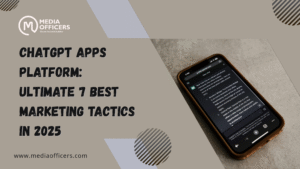The ChatGPT apps platform is redefining how brands reach people inside conversations, turning chat into a launchpad for services, tools, and commerce. For marketers, this shift promises contextually relevant encounters at moments of intent rather than waiting for a search query. As OpenAI expands what happens inside a chat, brands have a rare chance to meet consumers where they already are in dialogue.
What is the ChatGPT Apps Platform?
At its core, the ChatGPT apps platform treats apps not as separate software pieces but as integrated actions you can invoke within a conversation. Users can call an app by name, for example Figma, turn this sketch into a diagram, or ask ChatGPT to surface a service automatically based on context, such as Booking.com when planning a trip. This makes the experience feel less like a switch to another tool and more like a natural extension of the chat itself.
The platform supports dynamic visuals and interactive UI elements through the Apps SDK, so brands can deliver in-chat experiences that feel native rather than disruptive. Instead of forcing a user to toggle between screens, marketers can embed listings, designs, or product picks directly in the conversation thread.
Crucially, this approach reframes apps as actions within conversation, not standalone applications. A user might say, “Show me designer templates,” and an Canva-like app could respond with editable options right in the chat. The result is a seamless flow where intent is fulfilled without leaving the dialogue.
Why This Matters for Marketing
For marketers, the emergence of a ChatGPT apps platform signals a shift from keyword dependence to context-driven engagement. People are already chatting in trusted spaces, and the platform enables brands to appear in those moments of need without waiting for a search query.
- Massive reach: OpenAI’s user base has grown to hundreds of millions, creating a broad canvas for discovery as users engage with the platform in everyday tasks.
- Contextual discovery: Rather than surfacing ads or pages after a user types a query, brands surface relevant apps during a spontaneous description of needs a subtle but powerful shift in visibility.
- Interactive experiences: The Apps SDK enables visuals, maps, and dynamic UIs inside chat. Think Zillow listings with embedded maps, or Canva designs that can be refined in real time, all within the conversation.
- One-click paths to action: The potential for frictionless conversions increases when a user can move from intent to transaction without leaving the chat.
From a marketing perspective, this is a transformation of discovery and engagement. The platform sits at the intersection of AI, e-commerce, and user experience, offering an opportunity to accelerate conversions at moments of high intent.
How the Platform Works for Brands
Calling apps by name
Brands can be surfaced when a user explicitly requests a service. For example, a user might say, “Can you open Spotify and play a playlist for this mood?” or “Show me a car rental for tomorrow.” When the user names an app, the platform activates it inside the chat, creating a frictionless experience that blends search-like discovery with direct action.
Contextual auto-suggestions
ChatGPT can surface apps automatically based on the surrounding conversation. If a user discusses travel, Booking.com or Expedia could appear as suggested options, streamlining decision-making and increasing the likelihood of a conversion. This automatic relevance helps brands appear at the exact moment of need, not just when a user types a precise query.
To maximize impact, brands should design their app experiences to be chat-native designed for quick decisions, minimal input, and immediate value. This means concise prompts, actionable outputs, and visuals that render cleanly inside the chat window.
What This Means for Brand Marketing
The move toward a conversational operating system is more than a branding shift; it’s a reimagining of how customers discover, compare, and transact. Marketers can leverage the platform to create contextual experiences that feel personalized and timely, rather than intrusive. In practice, this could translate to a more human, assistant-like brand presence rather than banner-like interruptions.
- Quality over quantity: With a store-like app ecosystem in chat, brands that deliver high-design, fast-loading, and reliable Experiences will gain greater visibility.
- Rich, visual storytelling: The ability to present listings, maps, and designs in-chat enables more compelling product storytelling than text alone.
- Seamless discovery and conversion: When a user describes a need, an app can appear as the immediate next step, reducing the distance to purchase.
For consumers, this means fewer clicks and faster access to the right solution. For brands, it means a more intimate, real-time channel to demonstrate value and earn trust in the moment of decision.
What’s Next for Brands & Developers
OpenAI hints at an ambitious roadmap that will broaden the reach of the ChatGPT apps platform. Expect more brand integrations, including familiar names like Target, Uber, Peloton, and Instacart, each bringing dedicated experiences into chat. Developers can begin building now, with a formal app store and user reviews rolling out later this year. Higher design and functionality standards will determine visibility, rewarding products that deliver clear value in chat contexts.
Another intriguing concept is agentic commerce one-click transactions powered by AI. In tests, AI-enabled shopping experiences like Etsy in-chat purchases have shown how quickly a consumer can move from intent to checkout without leaving conversation. If scaling this approach, brands will need to address security, payment flows, and post-purchase support within the chat environment.
The big picture is clear: a single AI-mediated interface could become a primary path to brand interaction, discovery, and even commerce. Marketers who embrace the platform early can hone contextual engagement, foster loyalty through easier transactions, and unlock new forms of measurement that tie chat activity to business outcomes.
Strategic Playbook for Marketers
- Define the success metrics early. Decide whether you aim for app adoption, engagement depth, or direct revenue from in-chat transactions. Establish a baseline and set ambitious, but realistic, targets.
- Map the customer journey in chat. Identify where users describe needs, ask questions, or request specific services. Align app experiences with those moments of intent to reduce friction.
- Design for chat first. Create concise prompts, minimal input requirements, and outputs that can be consumed and acted on within seconds. Include rich visuals only where they add value and don’t overwhelm the user.
- Prioritize high-quality experiences. In an environment where discovery hinges on design and reliability, poorly performing apps will be weeded out quickly. Ensure fast load times, accurate data, and consistent behavior across devices.
- Adopt a testing mindset. Run A/B tests on prompts, app placements, and visual components to measure impact on engagement and conversions. Iterate based on data, not intuition alone.
- Think about attribution. Integrate in-chat actions with your broader marketing analytics to understand the contribution of the ChatGPT apps platform to funnel progression and revenue.
- Ensure safety and compliance. Maintain brand safety, user privacy, and clear opt-in/out mechanics for any in-chat interactions that involve data or payments.
Measuring Success in an AI-Mediated Interface
Traditional metrics like search rankings and page views take on new meaning when conversations drive discovery. The most actionable KPIs for the ChatGPT apps platform include engagement depth, app activation rate, and conversion rate within chat sessions. Beyond hard conversions, brands should track time in chat per session, repeat usage of specific apps, and the lift in awareness or consideration generated by in-chat experiences.
Quality of interaction matters as much as quantity. A delightful, informative, and frictionless in-chat experience can improve brand sentiment and lift long-term loyalty, even if immediate sales are modest. In the early stages, use a balanced mix of behavioral analytics, user feedback, and chat-specific experimentation to refine experiences.
Frequently Asked Questions
What is the ChatGPT apps platform?
The ChatGPT apps platform is an ecosystem that lets third-party apps live inside ChatGPT conversations. Users can invoke apps by name or ChatGPT can surface relevant apps based on the discussion, enabling actions such as booking a flight, generating a design, or displaying real-time listings directly within the chat.
How can brands start integrating apps with ChatGPT?
Brands can begin by exploring the Apps SDK and participating in OpenAI’s app development program. Start with a clear use case, design a chat-native experience, and test with a small group of users before scaling. Focus on ensuring fast, reliable, and visually engaging interactions that fit naturally into conversations.
What is agentic commerce?
Agentic commerce refers to AI-powered, one-click transactions initiated within chat. The goal is to reduce friction from discovery to checkout, enabling seamless purchases without leaving the conversation. Early tests include in-chat shopping experiences and simplified payment flows.
How do you measure ROI from in-chat apps?
Measure ROI by linking chat-driven actions to downstream outcomes: app activations, conversions, order value, and repeat purchases. Also track engagement metrics like time in chat, session frequency, and net promoter score to gauge user satisfaction and long-term impact.
Conclusion
The ChatGPT apps platform represents a landmark moment in AI-driven marketing. By embedding apps directly into conversations, brands can reach users at the exact moment of need, deliver rich and interactive experiences, and unlock new pathways to commerce. The road ahead includes a broader app ecosystem, more brand collaborations, and a shift toward measurable, in-chat outcomes. For marketers who embrace this platform with purpose and discipline, the opportunities to influence decisions, accelerate conversions, and build lasting relationships are substantial and increasingly within reach.





